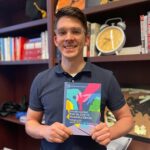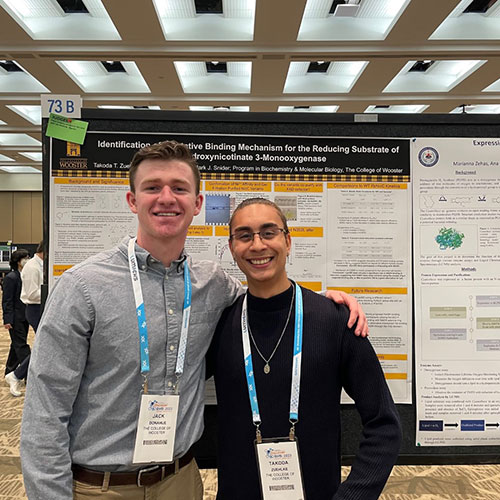
Wooster student wins honorable mention for I.S. research at National American Society of Biochemistry & Molecular Biology Meeting

A group of ten Wooster students attended this year’s National American Society of Biochemistry & Molecular Biology (ASBMB) meeting in Seattle, Washington, in March to present posters detailing the findings of their Independent Study and sophomore research projects from the past year. The students were accompanied by Dean Fraga, Danforth Professor of Biology and Mark Snider, Robert E. Wilson Professor of Chemistry and Biochemistry & Molecular Biology. Takoda Zuehlke ’23, an advisee of Snider, earned one of three honorable mentions at the National ASBMB Undergraduate Research Poster Competition in the category of enzyme structure-function for his work with the enzyme, NicC.
One of nine Wooster students to receive an award at the event since 2010, Zuehlke earned an honorable mention in the undergraduate poster competition for his investigation into a potential reducing-substrate (NADH) binding site in NicC, the enzyme of study for students in Snider’s lab. In his project, Zuehlke mutated two amino acid residues that he hypothesized could be involved in binding NADH. The mutated enzymes, called variants K300M and N352L, were compared to the mutation-free wild-type enzyme to determine the influence of these changes. “Our mode of comparison observed the catalytic rates and efficiency of these variants under different conditions,” described Zuehlke. From his findings, he determined that one of the amino acid residues, asparagine 352, likely participates in NADH binding.
As part of Snider’s lab, Zuehlke investigated how protein structure enables NicC’s function, working with the class to figure out how the enzyme binds NADH and the protein groups critical to that interaction. Zuehlke became fascinated by the project in an upper-level lab experience and chose to expand on it for his I.S. project. “Through the I.S. process, I acquired the necessary skills to develop my individual research questions,” he said. To pursue conclusive evidence regarding his research hypotheses, he learned advanced laboratory techniques such as stopped-flow spectrophotometry to track the kinetics of the NicC-catalyzed reaction on a millisecond timescale. Using genetic engineering to create variants of the enzyme, he examined whether the changed portions of the enzyme affected its ability to bind and utilize NADH in its mechanism. Zuehlke’s results showed that while one of his variants did affect the enzyme’s ability to bind and use NADH, the story was more complex than he originally hypothesized. “The process taught me the value of collaboration with my peers,” Zuehlke explained, “such as sharing techniques that could be beneficial to one another’s research and helping form conclusion from our individual results.”
Snider says that Zuehlke’s research generated new ideas and questions for his next class to explore in the fall. “The projects my students work on are challenging, both in experimental approach and in their applied theories,” said Snider, “but they lend themselves to deep and meaningful research experiences from which students learn much.” All of Snider’s students presented research centered around the overarching project goal of his lab, to determine how bacteria in the environment have evolved degradation pathways for nicotinic acid (as a model for N-heterocyclic aromatic compounds). This class of molecule is common in pharmaceuticals, personal care products, and industrial solvents, and the compounds students work with in Snider’s lab are pervasive contaminants that commonly end up in the environment. Within Snider’s research program, each student pursues a different research question of interest, all examining the function of enzymes involved in degrading these contaminants to useful metabolites. “Together,” Snider said, “their results contribute to the larger body of knowledge to figure out this complex and challenging biological question.” Zuehlke will join the class next fall as a lab assistant, where he will lend his expertise and continue his research in NicC’s mechanism.
Zuehlke said the BCMB program has provided him with opportunities to design his own research questions, building his confidence in his investigatory skills. Overall, “The program motivated me to be invested in my I.S. research topic and enabled me to learn advanced laboratory techniques to better answer my own research questions,” he said, adding that it also taught him to have confidence in the research that he’s chosen to conduct.
Alongside Zuehlke, Wooster students Jack Donahue ’24, Eric Senanu Adadevoh ’23, Kira Boyce ’23, Kath Olson ’24, Sam L. Belsky ’23, Abigail Lyon ’24, and Sipara H. Semu ’25, all students in Snider’s lab, attended the conference. Also in attendance were Kyungjoo Kim ’23 and Seula Kim ’23, both advisees of Fraga. The students each presented a poster highlighting their research findings from their I.S. projects or sophomore research projects, and seniors also participated in the national poster competition.
The National ASBMB conference provides biochemists and molecular biologists with the opportunity to present their published and unpublished findings with peers and colleagues. The meeting brings together scientists (both from academic and industrial areas) to share and discuss cutting-edge research in the broad area of these disciplines. Each Wooster student had the opportunity to share their novel contributions and examine the findings of other scientists in attendance. “The students were exposed to cutting edge science that may have ignited their imaginations about future possibilities,” said Fraga. Presentations of graduate level research provided students opportunities to listen to innovative research from a multitude of institutions, as well as connect with professors from graduate programs across the country.
Over the last ten years, Wooster students have consistently been recognized for the quality and depth of their research. “It’s an incredible achievement,” Snider explained “and speaks highly of the quality of the research mentoring and experiences for students at The College of Wooster.” Fraga concurred, describing his experience at the conference as “heartwarming.” “Watching our students perform on a national stage like that and seeing them shine, makes us appreciate how amazing our independent study program is at preparing students for the real world,” he affirmed. “It also reminds us that we attract very ambitious and hardworking students.”
Image: Jack Donahue ’24 and Takoda Zuehlke ’23 presented posters on their research at the National American Society of Biochemistry & Molecular Biology (ASBMB) meeting in Seattle, Washington.
Posted in News on May 15, 2023.
Related Posts
Related Areas of Study
Biochemistry & Molecular Biology
Biology and Chemistry combine in an interdisciplinary program for students with a passion for molecular events.
Major

